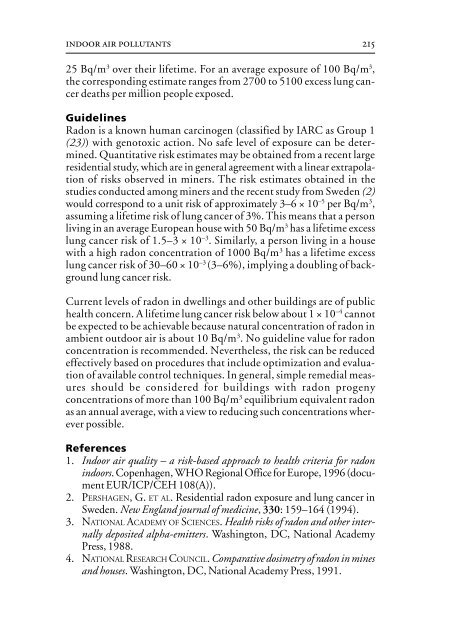Air Quality Guidelines - World Health Organization Regional Office ...
Air Quality Guidelines - World Health Organization Regional Office ...
Air Quality Guidelines - World Health Organization Regional Office ...
You also want an ePaper? Increase the reach of your titles
YUMPU automatically turns print PDFs into web optimized ePapers that Google loves.
indoor air pollutants<br />
215<br />
25 Bq/m 3 over their lifetime. For an average exposure of 100 Bq/m 3 ,<br />
the corresponding estimate ranges from 2700 to 5100 excess lung cancer<br />
deaths per million people exposed.<br />
<strong>Guidelines</strong><br />
Radon is a known human carcinogen (classified by IARC as Group 1<br />
(23)) with genotoxic action. No safe level of exposure can be determined.<br />
Quantitative risk estimates may be obtained from a recent large<br />
residential study, which are in general agreement with a linear extrapolation<br />
of risks observed in miners. The risk estimates obtained in the<br />
studies conducted among miners and the recent study from Sweden (2)<br />
would correspond to a unit risk of approximately 3–6 × 10 –5 per Bq/m 3 ,<br />
assuming a lifetime risk of lung cancer of 3%. This means that a person<br />
living in an average European house with 50 Bq/m 3 has a lifetime excess<br />
lung cancer risk of 1.5–3 × 10 –3 . Similarly, a person living in a house<br />
with a high radon concentration of 1000 Bq/m 3 has a lifetime excess<br />
lung cancer risk of 30–60 × 10 –3 (3–6%), implying a doubling of background<br />
lung cancer risk.<br />
Current levels of radon in dwellings and other buildings are of public<br />
health concern. A lifetime lung cancer risk below about 1 × 10 –4 cannot<br />
be expected to be achievable because natural concentration of radon in<br />
ambient outdoor air is about 10 Bq/m 3 . No guideline value for radon<br />
concentration is recommended. Nevertheless, the risk can be reduced<br />
effectively based on procedures that include optimization and evaluation<br />
of available control techniques. In general, simple remedial measures<br />
should be considered for buildings with radon progeny<br />
concentrations of more than 100 Bq/m 3 equilibrium equivalent radon<br />
as an annual average, with a view to reducing such concentrations wherever<br />
possible.<br />
References<br />
1. Indoor air quality – a risk-based approach to health criteria for radon<br />
indoors. Copenhagen, WHO <strong>Regional</strong> <strong>Office</strong> for Europe, 1996 (document<br />
EUR/ICP/CEH 108(A)).<br />
2. PERSHAGEN, G. ET AL. Residential radon exposure and lung cancer in<br />
Sweden. New England journal of medicine, 330: 159–164 (1994).<br />
3. NATIONAL ACADEMY OF SCIENCES. <strong>Health</strong> risks of radon and other internally<br />
deposited alpha-emitters. Washington, DC, National Academy<br />
Press, 1988.<br />
4. NATIONAL RESEARCH COUNCIL. Comparative dosimetry of radon in mines<br />
and houses. Washington, DC, National Academy Press, 1991.

















